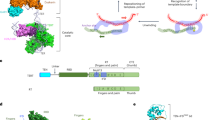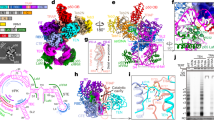Abstract
The maintenance of chromosome termini, or telomeres, requires the action of the enzyme telomerase, as conventional DNA poly-merases cannot fully replicate the ends of linear molecules1–4. Telomerase is expressed and telomere length is maintained in human germ cells and the great majority of primary human tumours5,6. However, telomerase is not detectable in most normal somatic cells; this corresponds to the gradual telomere loss observed with each cell division7–9. It has been proposed that telomere erosion eventually signals entry into senescence or cell crisis and that activation of telomerase is usually required for immortal cell proliferation10. In addition to the human telomerase RNA component (hTR; ref. 11), TP1/TLP1 (refs 12,13), a protein that is homologous to the p80 protein associated with the Tetrahymena enzyme14, has been identified in humans. More recently, the human telomerase reverse transcriptase (hTRT; refs 15, 16), which is homologous to the reverse transcriptase (RT)-like proteins associated with the Euplotes aediculatus (Ea_p123), Saccharomyces cerevisiae (Est2p) and Schizosaccharomyces pombe (SpTrt!) telomerases15,17, has been reported to be a telomerase protein subunit. A catalytic function has been demonstrated for Est2p in the RT-like class but not for p80 or its homologues17,18. We now report that in vitro transcription and translation of hTRT when co-synthesized or mixed with hTR reconstitutes telomerase activity that exhibits enzymatic properties like those of the native enzyme. Single amino-acid changes in conserved telomerase-specific and RT motifs reduce or abolish activity, providing direct evidence that hTRT is the catalytic protein component of telomerase. Normal human diploid cells transiently expressing hTRT possessed telomerase activity, demonstrating that hTRT is the limiting component necessary for restoration of telomerase activity in these cells. The ability to reconstitute telomerase permits further analysis of its biochemical and biological roles in cell aging and carcinogenesis.
This is a preview of subscription content, access via your institution
Access options
Subscribe to this journal
Receive 12 print issues and online access
$209.00 per year
only $17.42 per issue
Buy this article
- Purchase on Springer Link
- Instant access to full article PDF
Prices may be subject to local taxes which are calculated during checkout
Similar content being viewed by others
References
Olovnikov, A.M. A theory of marginotomy: the incomplete copying of template margin in enzymic synthesis of pronucleotides and biological significance of the phenomenon. J. Theor. Biol. 41, 181–190 (1973).
Watson, J.D. Origin of concatemeric T7 DNA. Nature New Biol. 239, 197–201 (1972).
Blackburn, E.H. Structure and function of telomeres. Nature 350, 569–573 (1991).
Lingner, J., Cooper, J.P. & Cech, T.R. Telomerase and DNA replication: no longer a lagging strand problem? Science 269, 1533–1534 (1995).
Harley, C.B. et al. Telomerase, cell immortality, and cancer. Cold Spring Harbor Symp. Quant. Biol. 59, 307–315 (1994).
Kim, N.W. et al. Specific association of human telomerase activity with immortal cells and cancer. Science 266, 2011–2014 (1994).
Harley, C.B., Futcher, A.B. & Greider, C.W. Telomeres shorten during ageing of human fibroblasts. Nature 345, 458–460 (1990).
Chiu, C.-P. et al. Differential expression of telomerase activity in hematopoietic progenitors from adult human bone marrow. Stem Cells 14, 239–248 (1996).
Shay, J.W. & Bacchetti, S. A survey of telomerase activity in human cancer. Eur. J. Cancer 33, 777–791 (1997).
Harley, C.B. Telomere loss: mitotic clock or genetic time bomb? Mutat. Res. 256, 271–282 (1991).
Feng, J. et al. The RNA component of human telomerase. Science 269, 1236–1241 (1995).
Harrington, L. et al. A mammalian telomerase-associated protein. Science 274, 973–977 (1997).
Nakayama, J., Saito, M., Nakamura, H., Matsuura, A. & Ishikawa, F. TLP1: a gene encoding a protein component of mammalian telomerase is a novel member of WD repeats family. Cell 88, 1–20 (1997).
Collins, K., Kobayashi, R. & Greider, C.W. Purification of Tetrahymena telomerase and cloning of genes encoding the two protein components of the enzyme. Cell 81, 677–686 (1995).
Nakamura, T.M. et al. Telomerase catalytic subunit homologs from fission yeast and human. Science 277, 955–959 (1997).
Meyerson, M.I. et al. hEST2, the putative human telomerase catalytic subunit gene, is up-regulated in tumor cells and during immortalization. Cell 90, 785–795 (1997).
Lingner, J., Hughes, T.R., Shevchenko, A., Mann, M., Lundblad, V. & Cech, T.R. Reverse transcriptase motifs in the catalytic subunit of telomerase. Science 276, 561–567 (1997).
Counter, C.M., Meyerson, M., Eaton, E.N. & Weinberg, R.A. A catalytic subunit of yeast telomerase. Proc. Watl. Acad. Sci. USA 94, 9202–9207 (1997).
Morin, G.B. The human telomere terminal transferase enzyme is a ribonucleoprotein that synthesizes TTAGGG repeats. Cell 59, 521–529 (1989).
Morin, G.B. The implications of telomerase biochemistry for human disease. Eur. J. Cancer 33, 750–760 (1997).
Morin, G.B. Recognition of a chromosome truncation site associated with alpha thalassaemia by human telomerase. Nature 353, 454–456 (1991).
Joyce, C.M. & Steitz, T.A. Function and structure relationships in DNA polymerases. Annu. Rev. Biochem. 63, 777–822 (1994).
Sousa, R. Structural and mechanistic relationships between nucleic acid polymerases. TIBS 21, 186–190 (1996).
Autexier, C., Pruzan, R., Funk, W.D. & Greider, C.W. Reconstitution of human telomerase activity and identification of a minimal functional region of the human telomerase RNA. EMBO J. 15, 5928–5935 (1996).
Perez, D.H., Vilander, L., Andrews, W.H. & Holmes, R. Human formyl peptide receptor ligand binding domain(s): studies using an improved mutagenesis/expression vector reveal a novel mechanism or the regulation of receptor occupancy. J. Biol. Chem. 269, 22485–22487 (1994).
Lin, J.-H., Wang, M., Andrews, W.H., Wydro, R. & Morser, J. Expression efficiency of the human thrombomodulin-encoding gene in various vector and host systems. Gene 147, 287–292 (1994).
Melton, D.A., Krieg, P.A., Rebagliati, M.R., Maniatis, T., Zinn, K. & Green, M.R. Efficient in vitro synthesis of biologically active RNA and RNA hybridization probes from plasmids containing a bacteriophage SP6 promoter. Nucleic Acids Res. 12, 7035–7056 (1984).
Studier, F.W. & Moffatt, B.A. Use of bacteriophage T7 RNA polymerase to direct selective high-level expression of cloned genes. J. Mol. Biol. 189, 113–130 (1986).
Kim, N.W. & Wu, F. Advances in quantification and characterization of telomerase activity by the telomeric repeat amplification protocol (TRAP). Nucleic Acids Res. 25, 2595–2597 (1997).
Pruzan, R., Furneaux, H., Lassota, P., Hong, G.Y. & Hurwitz, J. Assemblage of the prespliceosome complex with separated fractions isolated from HeLa cells. J. Biol. Chem. 265, 2804–2813 (1990).
Bodnar, A., Kim, N.W., Effros, R.B. & Chiu, C.-P. Mechanism of telomerase induction during T cell activation. Exp. Cell Res. 228, 58–64 (1996).
Author information
Authors and Affiliations
Corresponding author
Rights and permissions
About this article
Cite this article
Weinrich, S., Pruzan, R., Ma, L. et al. Reconstitution of human telomerase with the template RNA component hTR and the catalytic protein subunit hTRT. Nat Genet 17, 498–502 (1997). https://doi.org/10.1038/ng1297-498
Received:
Accepted:
Issue Date:
DOI: https://doi.org/10.1038/ng1297-498
This article is cited by
-
Liposomal delivery of gene therapy for ovarian cancer: a systematic review
Reproductive Biology and Endocrinology (2023)
-
Atypical Case of Highly Mutated h-TERT Promoter in Germline Genome from Buccal Mucosa Cancer
Indian Journal of Clinical Biochemistry (2023)
-
Marcatori genetici di aggressività nel carcinoma papillare della tiroide (PTC)
L'Endocrinologo (2022)
-
The overexpression of Tipe2 in CRC cells suppresses survival while endogenous Tipe2 accelerates AOM/DSS induced-tumor initiation
Cell Death & Disease (2021)
-
Telomerase reverse transcriptase preserves neuron survival and cognition in Alzheimer’s disease models
Nature Aging (2021)



